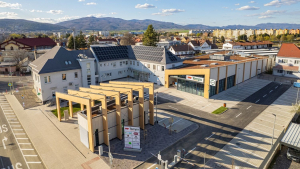
In 6-12 months, investors will return to the real estate market in Poland. The desirable assets will be data centres and products of the living sector, including PRS and PBSA - these were the conclusions reached by the participants of the panel on collaborative and alternative investment strategies at this week’s CEE Property Financing Update 2024 conference in Warsaw. The event was organised by Property Forum and hosted by law firm CMS.
Recent years in the Polish investment market have been marked by a drought. The participants of the panel chaired by Agata Jurek-Zbrojska, Partner, Head of Real Estate and Construction at CMS Poland agreed that the war in Ukraine and, in particular, the high cost of capital in the eurozone and across the pond caused many Western investment funds to go into wait-and-see mode. The situation was taken advantage of by investors from the Baltic States and the Czech Republic, who entered the Polish market with vigour, investing in office buildings and shopping centres, among other things.
Jaroslav Kysela, a Member of the Board of Directors of Investika explained that phenomenon: “It`s simple, Poland offers a higher yield than the Czech Republic. The Czech Republic is a small country compared to Poland and we are not as flexible in terms of giving permits to developers, so it takes much longer than in Poland to develop the building. Therefore, the demand here is higher than the supply. What is also interesting, is that 80% of Czech commercial real estate today is owned by local capital. It helps keep the price stable in the country and it also means that our market wasn't impacted during Covid and the inflation wave of recent years. The Polish market is more exposed to foreign capital and related risks. Distressed foreign investors would decide to dispose of some of the assets with reduced prices. That`s why Poland is attractive to Czech investors - because it offers quality products, attractive pricing, and it's also a country which we are familiar with, which we think we understand better than, for example, Germany”.
Mark Richardson, Head of Investment at Savills Poland, stated that the conflict between Russia and Ukraine is not an issue anymore for the investors interested in the assets located in Poland. “I think the perception of the Western funds is that the CEE market is improving. In their opinion, Poland is actually a country that, once again, people are looking to invest in, which is great. I think that any concerns they had about the geographic proximity to Ukraine and the conflict are gone now., said Richardson.
It is no secret that in recent years the most popular assets in Poland have been the so-called ‘beds & sheds’. This state of affairs is likely to continue here for longer - the demand for warehouses is not waning, and for some of its products, such as data centres, it will even grow in the coming years. The situation is similar in the living sector. The development of the PRS segment is gaining momentum, and investors are also increasingly interested in private student apartments (PBSA).
“There's a huge amount of students in Poland, both Polish and foreign. Not all the student accommodation is being taken by foreign students, so I think there's some affordability among Polish students as well, and it's increasing. We would like to make a product which both foreign and Polish students could afford. With just 12,000 modern beds for 1.2 million students, I don't think there are many countries in Europe which have such a dramatic level of difference between the two” said Renata McCabe-Kudła, Country Manager of Grupo Lar Poland, which has recently announced plans to enter the PBSA market.
Demand for this asset class seems to be so high that it is becoming increasingly viable to change building functions, i.e. convert older, non-green office buildings into student accommodation.
“I think there are locations in Polish cities, where there is a huge market for residential conversions. For these, where you can buy office buildings for below €1000 per square meter, and the bare land would be probably more expensive. Residential is taking over more space than in the past and that's a natural growth of the cities. I think probably half a million square meters of offices in Polish cities in the next 12 months will be turned residential. Especially the buildings without the raised floors are very suitable for student housing and accommodation, as they are much cheaper in conversion than the buildings built in the last 10 years”, predicts Dorota Latkowska-Diniejko MRICS, Vice-President of the Management Board of REINO Partners.



